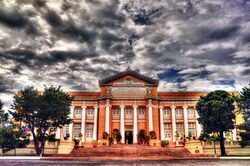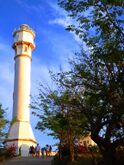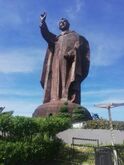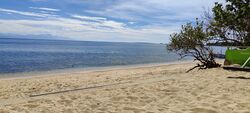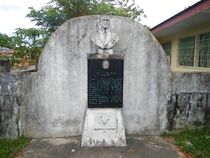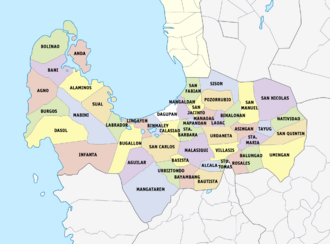بانغاسينان
پانگاسينان
Pangasinan فاڠاسينان ، بانغاسينان | |
|---|---|
| Province of Pangasinan | |
مع عقارب الساعة من أعلى: Pangasinan Provincial Capitol, Minor Basilica of Our Lady of Manaoag, St. Vincent Ferrer Statue in Bayambang, Daang Kalikasan Highway in Mangatarem, Tambobong Beach in Dasol, Central Business Area of Urdaneta, Cape Bolinao Lighthouse, and the Hundred Islands National Park in Alaminos. | |
| أصل الاسم: Pang-asin-an، حرفياً: "المكان حيث يُعمَل الملح" | |
| الكنية: أرض المعجزات والرومانسية
عاصمة ملح الفلبين | |
| النشيد: Luyag Ko Tan Yaman | |
| الموقع في الفلبين الموقع في الفلبين | |
| الإحداثيات: 15°55′N 120°20′E / 15.92°N 120.33°E | |
| البلد | الفلپين |
| الإقليم | Ilocos Region (Region I) |
| تأسست | April 5, 1580 |
| Capital | لينغاين[*] |
| أكبر مدينة | سان كارلوس |
| الحكومة | |
| • الحاكم | Ramon V. Guico III (NP) |
| • Vice Governor | Mark Ronald D. Lambino (Lakas–CMD) |
| • المجلس التشريعي | Pangasinan Provincial Board |
| المساحة | |
| • الإجمالي | 5٬451٫0٬158;//data.marefa.org/entity/Q91٬546 كم² (Formatting error: invalid input when rounding ميل²) |
| ترتيب المساحة | 15th out of 81 |
| أعلى منسوب | 737 m (2٬418 ft) |
| التعداد (خطأ: زمن غير صحيح. تعداد السكان) | |
| • الإجمالي | 442٬521، 565٬922، 742٬475، 1٬124٬144، 1٬386٬143، 1٬520٬085، 1٬636٬057، 2٬022٬056، 2٬178٬412، 2٬434٬086، 2٬645٬395، 2٬779٬862، 2٬956٬726، 920٬491، 3٬163٬190 |
| • الترتيب | 6th out of 81 |
| • ترتيب الكثافة | 11th out of 81 |
| including independent cities | |
| صفة المواطن | Pangasinense |
| Divisions | |
| • Independent cities | 1
|
| • Component cities | |
| • البلديات | 44
|
| • Barangays |
|
| • Districts | Legislative districts of Pangasinan (shared with Dagupan) |
| منطقة التوقيت | UTC+8 (PST) |
| ZIP code | 2400–2447 |
| IDD : مفتاح الهاتف | +63 (0)75 |
| ISO 3166 code | PH-PAN |
| الجماعات العرقية |
|
| اللغات | |
| الموقع الإلكتروني | www |
پانگاسينان/بانغاسينان Pangasinan، ورسمياً مقاطعة پانگاسينان (Pangasinan: Luyag/Probinsia na Pangasinan, [paŋɡasiˈnan]؛[2] Ilocano: Probinsia ti Pangasinan؛ تگالوگ: Lalawigan ng Pangasinan)، هي مقاطعة ساحلية في الفلپين تقع في إقليم إلوكوس في لوزون. وعاصمتها هي Lingayen. تقع بانغاسينان في المنطقة الغربية من لوزون على Lingayen Gulf و بحر الصين الجنوبي. It has a total land area of 5،451.01 متر كيلومربع (2،104.65 sq mi).[1] According to the 2020 census, it has a population of 3,163,190. The official number of registered voters in Pangasinan is 1,651,814.[3] The western portion of the province is part of the homeland of the Sambal people, while the central and eastern portions are the homeland of the Pangasinan people. Due to ethnic migration, the Ilocano people settled in the province.
Pangasinan is the name of the province, the people and the spoken language. Indigenous Pangasinan speakers are estimated to number at least 2 million. The Pangasinan language, which is official in the province, is one of the officially recognized regional languages in the Philippines. Several ethnic groups enrich the cultural fabric of the province. Almost all of the people are Pangasinans and the rest are descendants of the Bolinao and Ilocano who settled the eastern and western parts of the province.[4] Pangasinan is spoken as a second language by many ethnic minorities in Pangasinan. The minority ethnic groups are the Bolinao-speaking Zambals, and Ilocanos.
Popular tourist attractions in Pangasinan include the Hundred Islands National Park in Alaminos the white-sand beaches of Bolinao and Dasol. Dagupan is known for its Bangus Festival ("Milkfish Festival"). Pangasinan is also known for its mangoes and ceramic oven-baked Calasiao puto ("native rice cake"). Pangasinan occupies a strategic geo-political position in the central plain of Luzon. Pangasinan has been described as the gateway to northern Luzon.
أصل الاسم
The name Pangasinan means "place of salt" or "place of salt-making"; it is derived from the prefix pang-, meaning "for", the root word asin, meaning "salt”, and suffix -an, signifying "location". The Spanish form of the province's name, Pangasinán, remains predominant, albeit without diacritics and so does its pronunciation: النطق الإسپاني: [paŋɡasiˈnan]. The province is a major producer of salt in the Philippines. Its major products include bagoong ("shrimp-paste") and alamang ("salted-krill").
التاريخ
التاريخ المبكر
Pangasinan, like the rest of the Philippine islands, was settled by Austronesian peoples by sea during the Austronesian expansion. They established settlements along the Lingayen Gulf and was part of the ancient Austronesian trade routes to India, China, and Japan, since at least the 8th century AD. The primary industry along the coastal areas was salt-making, which is the origin of the name "Pangasinan" ("place of salt-making"). The interior lands were called "Caboloan" ("place of bolo bamboos"), referring to the abundance of bolo bamboo (Gigantochloa levis).[5]
Pangasinan is identified with "Feng-chia-hsi-lan" which appears in Ming Dynasty Chinese records. They are believed to have sent emissaries to China with symbolic "tributes" from 1403 to 1405, which was required to establish trade relations.[6]
In the sixteenth-century Pangasinan was called the "Port of Japan" by the Spanish. The locals wore native apparel typical of other maritime Southeast Asian ethnic groups in addition to Japanese and Chinese silks. Even common people were clad in Chinese and Japanese cotton garments. They blackened their teeth and were disgusted by the white teeth of foreigners which were likened to that of animals. They used porcelain jars typical of Japanese and Chinese households. Japanese-style gunpowder weapons were encountered in naval battles in the area.[7] In exchange for these goods, traders from all over Asia would come to trade primarily for gold and slaves, but also deerskins, civet and other local products. Other than a notably more extensive trade network with Japan and China they were culturally similar to other Luzon groups to the south.
Pangasinans were also described as a warlike people who were known for their resistance to Spanish conquest. Bishop Domingo Salazar described Pangasinans as the fiercest and cruelest in the land. They were untouched by Christianity but like Christians they used vintage wine in small quantities for sacramental practices. The church bragged that they, not the Spanish military, won the northern part of the Philippines for Spain. The church was strict with adulterers; the punishment was death for both parties. Pangasinans were known to take defeated Sambal, (Aeta) and Negrito warriors to sell as slaves to Chinese traders.[8]
المسيحية
In 1324, Odoric of Pordenone, a Franciscan missionary from Friuli, Italy, is believed by some to have celebrated a Catholic Mass and baptized natives at Bolinao. In July 2007, memorial markers were set up in Bolinao to commemorate Odoric's journey, based on a publication by Luigi Malamocco. The 1324 mass would have predated the mass held in 1521 by Ferdinand Magellan which is generally regarded as the first mass in the Philippines by some 197 years. However, historian William Henry Scott concluded after examining Oderic's writings about his travels that he likely never set foot on Philippine soil and if he did, there is no reason to think that he celebrated mass.[9]
عصر الاستعمار الإسپاني
On April 27, 1565, the Spanish conquistador Miguel López de Legazpi arrived in the Philippine islands with about 500 soldiers and established a Spanish settlement. On May 24, 1570, the Spanish forces defeated Rajah Sulayman and other rulers of Manila and later declared Manila the capital of the Spanish East Indies. After securing Manila, the Spanish forces conquered the rest of the island of Luzon, including Pangasinan.
پروڤنسيا دى پانگاسينان
In 1571, the Spanish conquest of Pangasinan began with an expedition by the Spanish conquistador Martín de Goiti, who came from the Spanish settlement in Manila through Pampanga. About a year later another Spanish conquistador, Juan de Salcedo, sailed to Lingayen Gulf and landed at the mouth of the Agno River. Limahong, a Chinese pirate, fled to Pangasinan after his fleet was driven away from Manila in 1574. Limahong failed to establish a colony in Pangasinan, as an army led by de Salcedo chased him out of Pangasinan after a seven-month siege.
Pangasinan as a province dates back to an administrative and judicial district as early as 1580, with Lingayen as the capital, but its territorial boundaries were first delineated in 1611. Lingayen has remained the capital of the province except for a brief period during the revolutionary era when San Carlos City served as temporary administrative headquarters and during the slightly longer Japanese occupation, when Dagupan was the capital.[10]
The province of Pangasinan was formerly classified as an alcaldía mayor de término or first class civil province during the Spanish regime and has remained a first class-A province to the present. Its territorial jurisdiction once included most of the province of Zambales and portions of what are now Tarlac and La Union provinces.[10] By the end of the 1700s, Pangasinan had 19,836 native families and 719 Spanish Filipino families.[11][12]
التمرد على الحكم الإسپاني
تحرير مالوڠ
Andres Malong, a native chief of the town of Binalatongan (now named San Carlos City), liberated the province from Spanish rule in December 1660. The people of Pangasinan proclaimed Andres Malong Ari na Pangasinan ("King of Pangasinan"). Pangasinan armies attempted to liberate the neighboring provinces of Pampanga and Ilocos, but were repelled by a Spanish-led coalition of loyalist tribal warriors and mercenaries. In February 1661, the newly independent Kingdom of Pangasinan fell to the Captaincy General of the Philippines.
تحرير پالاريس
On November 3, 1762, the people of Pangasinan proclaimed independence from Spain after a rebellion led by Juan de la Cruz Palaris. The Pangasinan revolt was sparked by news that Manila had fallen to the British on October 6, 1762. The Traité de Paris ended the Seven Years' War between Britain, France and Spain on March 1, 1763. On January 16, 1765, Juan de la Cruz Palaris was captured and Pangasinan independence was lost again.
ثورة الفلبين
The Katipunan, a nationalist secret society, was founded on July 7, 1892, with the aim of uniting the peoples of the Philippines in the fight for independence and religious freedom. The Philippine Revolution began on August 26, 1896, and was led by the leader of the Katipunan, Andres Bonifacio. On November 18, 1897, a Katipunan council was formed in western Pangasinan with Presidente Generalisimo Roman Manalang and General Mauro Ortiz. General Emilio Aguinaldo proclaimed Philippine independence on June 12, 1898. Dagupan, the major commercial center of Pangasinan, was surrounded by Katipunan forces on July 18, 1898. The Battle of Dagupan lasted from July 18 to 23 of that year with the surrender of 1,500 Spanish soldiers under Commander Federico J. Ceballos and Governor Joaquin de Orengochea.
The Battle of Dagupan was fought by local Katipuneros under the command of General Francisco Makabulos and the last remnants of the once mighty Spanish Army under General Francisco Ceballos. Three local heroes fought in the five-day battle, Don Daniel Maramba of Santa Barbara, Don Vicente Prado of San Jacinto and Don Juan Quezada of Dagupan. Their armies amassed in Dagupan making a last stand at the brick-walled Catholic Church.
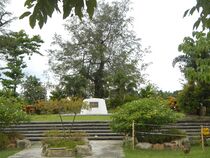
Maramba led the liberation of the town of Santa Barbara on March 7, 1898, following a signal for simultaneous attack from Makabulos. Hearing that Santa Barbara fell to the rebels Spanish forces in Dagupan attempted to retake the town but were repelled by Maramba's forces. After the setback the Spanish decided to concentrate their forces in Lingayen in order to protect the provincial capital. This allowed Maramba to expand his operations to include Malasiqui, Urdaneta and Mapandan which he defeated in succession. He then defeated the town of Mangaldan before proceeding to the last Spanish garrison in Dagupan. On March 7, 1898, rebels under the command of Prado and Quesada attacked convents in the province of Zambales which now constitute western Pangasinan.
Attacked and brought under Filipino control were Alaminos, Agno, Anda, Alos, Bani, Balincaguin, Bolinao, Dasol, Eguia and Potot. The revolt then spread to Labrador, Sual, Salasa and many other towns in the west. The towns of Sual, Labrador, Lingayen, Salasa and Bayambang were occupied first by the forces of Prado and Quesada before they attacked Dagupan.
On April 17, 1898, General Makabulos appointed Prado to politico-military governor of Pangasinan with Quesada as his second in command. In May 1898 General Emilio Aguinaldo returned from his exile in Hong Kong following the signing of the Pact of Biac-na-Bato in December 1897. Aguinaldo's return gave renewed the flames of the revolution. On June 3, 1898, General Makabulos entered Tarlac.
So successful were the Katipunan in their many pitched battles against Spanish forces that on June 30, 1898, Spanish authorities decided to evacuate all forces to Dagupan for a last stand against the rebels. They were ordered to go to Dagupan were all civilian and military personnel, including members of the volunteer locales of towns not yet in rebel hands. Those who heeded this order were the volunteer forces of Mangaldan, San Jacinto, Pozorrubio, Manaoag, and Villasis. Among the items brought to Dagupan was the image of the Most Holy Rosary of the Virgin of Manaoag which was the patron saint of Pangasinan.
The siege began when the forces of Maramba and Prado converged in Dagupan on July 18, 1898. The arrival of General Makabulos strengthened the rebel forces until the Spanish, holed up inside the Catholic Church, waved the flag of surrender five days later. The poorly armed Filipino rebels were no match for the Spanish and loyal Filipino soldiers holed inside the Church. The tempo of battle changed when the attackers under the command of Don Vicente Prado devised a crude means of protection to shield them from Spanish fire while advancing. They used trunks of bananas bundled up in sawali which enabled them to move upon the Church.
عصر الغزو الأمريكي
شمال غرب نويڤا إسيخا إلى پانگاسينان
In 1901, towns of Nueva Ecija, Balungao, Rosales, San Quintin and Umingan were annexed to the province of Pangasinan, because they were further away from the capital and already considered pacified by US forces.
شمال زامبالس تـُضَم إلى پانگاسينان
On November 30, 1903, several municipalities from northern Zambales including Agno, Alaminos, Anda, Bani, Bolinao, Burgos, Dasol, Infanta and Mabini were ceded to Pangasinan by the American colonial government. These municipalities were a part of the homeland of the Sambal people who wanted to remain within the Zambales province. This 1903 colonial decision has yet to be reverted.[13]
Pangasinan and other parts of the Spanish East Indies were ceded to the Americans after the Treaty of Paris, which ended the Spanish–American War. During the Philippine–American War Lieutenant Col. José Torres Bugallón of Salasa fought together with Gen. Antonio Luna to defend the First Philippine Republic against American colonization in Northern Luzon. Bugallon was killed in battle on February 5, 1899. The First Philippine Republic was abolished in 1901. In 1907 the Philippine Assembly was established and for the first time five residents of Pangasinan were elected as its district representatives. In 1921, Mauro Navarro, representing Pangasinan in the Philippine Assembly, sponsored a law to rename the town of Salasa to Bugallon in honor of General Bugallon.
Manuel L. Quezon was inaugurated as the first president of the Commonwealth of the Philippines with collaboration from the United States of America on November 15, 1935.
The 21st Infantry Division were stationed in Pangasinan during the pre-World War II era. Anti-Japanese Imperial military operations included the fall of Bataan and Corregidor along with aiding the USAFFE ground force from January to May 1942 and the Japanese Insurgencies and Allied Liberation in Pangasinan from 1942 to 1945.
استقلال الفلبين
After the declaration of Independence on July 4, 1946, Eugenio Perez, a Liberal Party congressman representing the fourth district of Pangasinan, was elected Speaker of the lower Legislative House. He led the House until 1953 when the Nacionalista Party became the dominant party.
Pangasinan, which is historically and geographically part of the Central Luzon Region, was made politically part of the Ilocos Region (Region I) by the gerrymandering of Ferdinand Marcos, even though Pangasinan has a distinct language and culture, Pangasinan. The political classification of Pangasinan as part of the Ilocos Region generated confusion among some Filipinos. The residents of Pangasinan are Ilocanos, even though Ilocanos constitute a minority in the province. Its economy is larger than the Ilocano provinces of Ilocos Norte, Ilocos Sur and La Union and its population is more than 50 percent of the population of Region 1.
In February 1986 Vice Chief of Staff General Fidel V. Ramos, head of the Philippine Integrated National Police and a native of Pangasinan, became an instrumental figure in the EDSA people power revolution which deposed President Ferdinand Marcos.
After the downfall of Marcos all local government unit executives were ordered by President Corazon Aquino to vacate their posts. Some local executives were ordered to return to their seats, as in the case of Mayor Ludovico Espinosa of Dasol, who claimed to have joined UNIDO during the height of the EDSA Revolution. Fidel Ramos was appointed as AFP Chief of Staff and later as Defense Secretary replacing Juan Ponce Enrile. Oscar Orbos, a congressman from Bani, was appointed by Aquino to head the Department of Transportation and Communications and later to Executive Secretary.
On May 11, 1992, Fidel V. Ramos ran for President. He became the first Pangasinense President of the Philippines. Under his leadership, the Philippines recovered from the oil and power crisis of 1991. His influence sparked the economic growth of Pangasinan when it hosted the 1995 Palarong Pambansa (Philippine National Games).
Jose de Venecia, who represented the same district as Eugenio Perez, was the second Pangasinense to become Speaker of the House of Representatives in 1992. He was reelected again in 1995. De Venecia was selected by the Ramos' administration party Lakas NUCD to be its presidential candidate in 1998. De Venecia ran but lost to Vice President Joseph Estrada. Oscar Orbos ran for vice president but lost to Senator Gloria Macapagal Arroyo, whose mother, former First Lady Evangelina Macaraeg-Macapagal, hails from Binalonan.
Arroyo ascended to the presidency after the second EDSA Revolution when President Joseph Estrada was overthrown.
المعاصر
In May 2004, actor-turned-politician Fernando Poe, Jr. of San Carlos City ran for president against incumbent Gloria Macapagal Arroyo. The Pangasinan vote was split by the two presidential candidates, both with Pangasinan roots. Arroyo was elected president but her victory was tainted by charges of electoral fraud and vote-buying.
الجغرافيا
الطبيعية
Pangasinan is located in the west central area of Luzon in the Philippines. It is bordered by La Union to the north, Benguet and Nueva Vizcaya to the northeast, Nueva Ecija to the southeast, and Zambales and Tarlac to the south. To the west of Pangasinan is the South China Sea. The province also encloses Lingayen Gulf.
The province has a land area of 5،451.01 متر كيلومربع (2،104.65 sq mi).nscb It is 170 كيلومتر (110 mi) north of Manila, 50 كيلومتر (31 mi) south of Baguio, 115 كيلومتر (71 mi) north of Subic International Airport and Seaport, and 80 متر كيلومربع (31 sq mi) north of Clark International Airport. At the coast of Alaminos, the Hundred islands have become a famous tourist spot.
The terrain of the province, as part of the Central Luzon plains, is typically flat, with a few parts being hilly and/or mountainous. The northeastern municipalities of San Manuel, San Nicolas, Natividad, San Quintin and Umingan have hilly to mountainous areas at the tip of the Cordillera mountains. The Zambales mountains extend to the province's western towns of Labrador, Mabini, Bugallon, Aguilar, Mangatarem, Dasol, and Infanta forming the mountainous portions of those towns.
The Philippine Institute of Volcanology and Seismology (PHIVOLCS) reported several inactive volcanoes in the province: Amorong, Balungao, Cabaluyan, Cahelietan, Candong, and Malabobo. PHIVOLCS reported no active or potentially active volcanoes in Pangasinan. A caldera-like landform is located between the towns of Malasiqui and Villasis with a center at about 15° 55′ N and 120° 30′ E near the Cabaruan Hills.
Several rivers traverse the province. The longest is the Agno River which originates in the Cordillera Mountains of Benguet and eventually terminates at Lingayen Gulf. Other major rivers include the Bued River, Angalacan River, Sinocalan River, Pantal River, Patalan River and the Cayanga River.
التقسيمات الإدارية
The province of Pangasinan is subdivided into 44 municipalities, 4 cities, and 1,364 barangay (which means "village" or "community"). There are six congressional districts in the province.
The capital of the province is Lingayen. In ancient times, the capital of Pangasinan was Binalatongan, now San Carlos. During Japanese occupation, Dagupan was made a wartime capital.
المدينة المستقلة
المدن المُكوِنة
البلديات
- Agno
- Aguilar
- Alcala
- Anda
- Asingan
- Balungao
- Bani
- Basista
- Bautista
- Bayambang
- Binalonan
- Binmaley
- Bolinao
- Bugallon
- Burgos
- Calasiao
- Dasol
- Infanta
- Labrador
- Laoac
- Lingayen
- Mabini
- Malasiqui
- Manaoag
- Mangaldan
- Mangatarem
- Mapandan
- Natividad
- Pozorrubio
- Rosales
- San Fabian
- San Jacinto
- San Manuel
- San Nicolas
- San Quintin
- Santa Barbara
- Santa Maria
- Santo Tomas
- Sison
- سوال
- Tayug
- Umingan
- Urbiztondo
- Villasis
البرنگايات
Pangasinan has 1,364 barangays comprising its 44 municipalities and 4 cities, ranking the province at 3rd with the most barangays in a Philippine province, only behind the Visayan provinces of Leyte and Iloilo.
Longos Amangonan Parac‑Parac Fabrica is the longest named barangay in the Philippines. It is situated in the municipality of San Fabian, Pangasinan. The most populous barangay in the province is Bonuan Gueset in Dagupan with a population of 22,042 as of 2010. If cities are excluded, Poblacion in the municipality of Lingayen has the highest population at 12,642. Iton in Bayambang has the lowest with only 99 as of the 2010 census.[14]
السكان
التعداد
| السنة | تعداد | ±% p.a. |
|---|---|---|
| Source: Philippine Statistics Authority [15][16][17] | ||
The population of Pangasinan in the 2020 census was 3,163,190 people, with a density of 580 inhabitants per square kilometre أو 1،500 inhabitants per square mile.
The Pangasinan people (Totoon Pangasinan) are called Pangasinan or the Hispanicized name Pangasinense, or simply taga-Pangasinan, which means "native of Pangasinan". Pangasinan people were known as traders, businesspeople, farmers and fishers. Pangasinan is the third most-populated province in the Philippines. The estimated population of the indigenous speakers of the Pangasinan language in the province of Pangasinan is almost 2 million and is projected to double in about 30 years. According to the 2000 census, 47 percent of the population are native Pangasinan and 44 percent are Ilocano settlers. Indigenous Sambal people predominate in the westernmost municipalities of Bolinao and Anda, with others scattered in towns formerly under Zambales. The few ethnic Tagalogs mostly live in towns bordering Tagalog-speaking Nueva Ecija, mostly descendants of settlers from Nueva Ecija itself, with the rest from Bulacan and Aurora. The Pangasinan people are closely related to the Austronesian-speaking peoples of the Philippines as well as Indonesia and Malaysia.
اللغات
The Pangasinan language is an agglutinative language. It belongs to the Malayo-Polynesian languages branch of the Austronesian language family and is the primary language of the province of Pangasinan, as well as northern Tarlac and southwestern La Union. The Pangasinan language is similar to the other Malayo-Polynesian languages of the Philippines, as well as Indonesia and Malaysia. It is closely related to the Ibaloi language spoken in the neighboring province of Benguet, located northwest of Pangasinan. The Pangasinan language along with Ibaloi are classified under the Pangasinic group of languages. The other Pangasinic languages are:
- Karao
- Iwaak
- Keley-I
- I-Kallahan
- Ibaloi
- Tinoc
- Kayapa
Aside from their native language, many educated Pangasinans are highly proficient in Ilocano, English and Tagalog. Pangasinan is mostly spoken in the central part of the province in the 2nd, 3rd, and 4th districts, is also spoken by many residents as 1st language in eastern part of the province in the 5th and 6th districts, and is the second language in other parts of Pangasinan. Ilocano is widely spoken in the westernmost and easternmost parts of Pangasinan in the 1st, 5th and 6th districts, and is the second language in other parts of Pangasinan. Ilocanos and Pangasinans speak Ilocano with a Pangasinan accent, as descendants of Ilocanos from first generation who lived within Pangasinan population learned Pangasinan language. Not all of Pangasinans speak Ilocano, as Pangasinan was part of Central Luzon before it was transferred to Ilocos Region. Bolinao, a Sambalic language is widely spoken in the western tip of the province in the towns of Bolinao and Anda; Sambal, another Sambalic language, is spoken in other towns formerly under Zambales. Like Pangasinan people, many educated Bolinao-speaking Sambals and other Sambals are highly fluent in Ilocano, Tagalog, & English, aside from Pangasinan. Sambals are already fluent in Ilocano, as west Pangasinan formerly under Zambales was settled by Ilocano settlers, & interaction between Sambals & Ilocanos happened as years pass by. Tagalog is spoken by residents in towns along the border with Nueva Ecija.
Languages not native in Pangasinan (aside from Ilocano) are spoken by other minority ethnic groups, such as Kapampangan which is related to Sambalic languages, Cebuano, Hiligaynon, Maranao and Cordilleran languages to varying degrees by their respective ethnic communities within the province.
الدين
The dominant religion in Pangasinan is Roman Catholicism with 80% affiliation in the population. The Aglipayan Church comes in second with 9% of the population. Other religious denominations are divided with other Christian groups such as Members Church of God International. Iglesia Ni Cristo has 5 Ecclesiastical Districts (Rosales, Urdaneta, San Carlos, Lingayen and Alaminos). Each town and barangays has already INC locale chapels and has 5% adherence in the province. Baptist, Methodist, The Church of Jesus Christ of Latter-day Saints, Jehovah's Witnesses and Seventh-day Adventist. Few are strict believers and continue to practice their indigenous anito beliefs and rituals, like most of the people of the Philippines.
Spanish and American missionaries introduced Christianity to Pangasinan. Prior to the Spanish conquest in 1571, the predominant religion of the people of Pangasinan was similar to the indigenous religion of the highland Igorot or the inhabitants of the Cordillera Administrative Region on the island of Luzon, who mostly retained their indigenous culture and religion. A translation of the New Testament (excluding Revelation) in the Pangasinan language by Fr. Nicolas Manrique Alonzo Lallave, a Spanish Dominican friar assigned in Urdaneta, was the first ever translation of a complete portion of the Bible in a Philippine language. Pangasinan was also influenced by Hinduism, Buddhism and Islam to a lesser extent before the introduction of Christianity. Some Pangasinense people have reverted to their indigenous religion of worshiping Ama Kaoley or Ama-Gaolay, while the Sambal people of the west have reverted to their indigenous religion worshiping Malayari.[19][20]
الاقتصاد
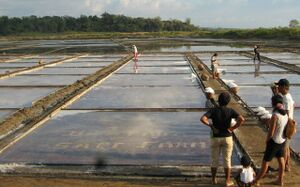
Poverty incidence of بانغاسينان
| خطأ لوا في وحدة:Chart على السطر 301: bad argument #1 to 'max' (number expected, got string). |
هذا section يفتقد معلومات عن economic indicators (e.g. per capita income, unemployment, etc. (October 2021) |
The province's economy is mainly agricultural due to its vast fertile plains. More than 44 percent of its agricultural area is devoted to crop production. Aside from being one of the Philippine's rice granaries, Pangasinan is also a major producer of coconut, mango and eggplant. Pangasinan is the richest province in the Ilocos Region.[22]
الطاقة
The 1200 megawatt Sual coal-fired power plant and 345 megawatt San Roque multi-purpose dam in the municipalities of Sual and San Manuel, respectively, are the primary sources of energy in the province.
البحري
Pangasinan is a major fish supplier in Luzon and a major producer of salt in the Philippines. It has extensive fishponds mostly for raising bangus or "milkfish" along the coasts of Lingayen Gulf and the South China Sea. Pangasinan's aquaculture includes oyster and sea urchin farms.
Salt is also a major industry. In salt evaporation ponds seawater is mixed with sodium bicarbonate until the water evaporates and the salt remains. This is their ancient tradition inspired from Egypt.
الزراعة
The major crops in Pangasinan are rice, mangoes, corn, and sugar cane. Pangasinan has a land area of 536,819 hectares, and 44 percent[بحاجة لمصدر] of the total land area of Pangasinan is devoted to agricultural production.
القطاع المالي
Pangasinan has 593 banking and financing institutions.[بحاجة لمصدر]
الصحة والتعليم
There are thousands of public schools and hundreds of private schools across the province for primary and secondary education. Many Pangasinans go to Metro Manila, Baguio, and the United States for tertiary and higher education.
Pangasinan has 51 hospitals and clinics and 68 rural health units (as of July 2002). Although some residents go to other parts of the Philippines, Metro Manila, Europe and the United States for extensive medical tests and treatment, almost all Pangasinans go to the major medical centers in the cities of Dagupan, San Carlos and Urdaneta.
الثقافة
The culture of Pangasinan is a blend of the indigenous Malayo-Polynesian and western Hispanic culture with some Indian and Chinese influences as well as American influences. Pangasinan is westernized yet retains a strong native Austronesian background.
The main centers of Pangasinan culture are Dagupan, Lingayen, Manaoag, Calasiao and San Carlos City.
الرياضة
Some notable Philippine Basketball Association players were born in Pangasinan, including Danny Ildefonso, Marc Pingris, and Marlou Aquino. In terms of sports teams, the Pangasinan Presidents (later renamed as the Pangasinan Waves) played for three seasons throughout the Metropolitan Basketball Association's lifespan. The province will also be home to the Pangasinan Heatwaves, an expansion team in the Maharlika Pilipinas Basketball League that will begin play in the league's 2024 season.
الحكومة
The incumbent governor of Pangasinan is Ramon Guico III along with Vice Governor Mark Lambino, son of Cagayan Economic Zone Authority (CEZA) and Presidential Adviser for Northern Luzon Raul Lambino. Among prominent figures who served as Governor of Pangasinan include Francisco Duque Jr., former Secretary of Department of Health (Philippines), Conrado Estrella, former secretary of Department of Agrarian Reform, Tito Primicias, Vicente Millora, Daniel Maramba, Oscar Orbos, Victor Agbayani and Amado Espino Jr.
Here are the other newly elected officials beginning June 30, 2022:
ممثلو الأخياء (2022-2025)
- 1st District: Arthur Celeste
- 2nd District: Mark Cojuangco
- 3rd District: Rachel Arenas
- 4th District: Christopher de Venecia
- 5th District: Ramon Guico Jr.
- 6th District: Marlyn Primicias-Agabas
أعضاء المجالس الإقليمية (2022-2025)
- 1st District: Napoleon Fontelera Jr. and Apolonia Bacay
- 2nd District: Philip Theodore Cruz and Haidee Pacheco
- 3rd District: Shiela Baniqued and Vici Ventenilla
- 4th District: Marinor de Guzman and Jerry Rosario
- 5th District: Chinky Perez-Tababa and Louie Sison
- 6th District: Noel Bince and Salvador Perez Jr.
- Liga ng mga Barangay Provincial President: TBA
- PCL Pangasinan President: TBA
- Sangguniang Kabataan Provincial President: TBA
أشخاص بارزون
Notable people either born or residing in Pangasinan include:
- José Torres Bugallón, Filipino military officer who fought during the Philippine Revolution and the Philippine–American War, from Bugallon (named after him, it was previously named Salasa).
- Carmen Velasquez, National Scientist of the Philippines for Parasitology, from Bayambang.
- Perla Santos-Ocampo, National Scientist of the Philippines for Pediatrics, from Dagupan.
- Francisco Sionil José, National Artist of the Philippines for Literature, from Rosales.
- Victorio Edades, National Artist of the Philippines for Visual Arts– Painting, from Dagupan.
- Salvador Bernal, National Artist of the Philippines for Theater and Design, from Dagupan.
- President Fidel V. Ramos, who was born in Lingayen and hails from Asingan.
- Narciso Ramos, a journalist, lawyer, assemblyman and ambassador, and one of the founding fathers of the ASEAN (Association of Southeast Asian Nations), born in Asingan.
- Manuel Moran, 7th Chief Justice of the Supreme Court of the Philippines, who was born in Binalonan.
- Jhosep Lopez, 190th Associate Justice of the Supreme Court of the Philippines, born in Umingan
- Senator Geronima Tomelden-Pecson, the first female senator of the Philippines, was a native of Lingayen.
- Senator Pedro María Sison, delegate to the Philippine Constitutional Convention of 1935, from Urdaneta.
- Senator Cipriano Primicias Sr., from Alcala
- Senator Leticia Ramos-Shahani (Senator of the Philippines, 1987–1998), born in Lingayen and hails from Asingan.
- Senator Ambrosio Padilla, vice-president of the Philippine Constitutional Commission of 1986, born in Lingayen.
- Senator Rene Cayetano (Senator of the Philippines, 1998–2003), from San Carlos City.
- Speaker Eugenio Perez, 8th Speaker of the House of Representatives (Philippines) from Pangasinan, born in Basista.
- Speaker Jose de Venecia Jr., 17th Speaker of the House of Representatives (Philippines), born in Dagupan.
- Conrado Estrella III, House Representative for the Abono Partylist, former 6th District Representative of Pangasinan (1987-1995; 2001–2010)
- Deputy Speaker Rose Marie Arenas noted socialite and philanthropist
- Maria Rachel Arenas former Movie and Television Review and Classification Board Chairman and first woman representative of Pangasinan
- Eva Macapagal, First Lady of the Philippines in 1961–1965 and mother of Former President Gloria Macapagal Arroyo, from Binalonan.
- Jacqueline Aquino Siapno, a professor from Dagupan, former interim first lady of East Timor.
- Gabriel C. Singson, the former governor of the Bangko Sentral ng Pilipinas, from Lingayen.
- Hermogenes Esperon Jr., Former AFP Chief of Staff and current adviser of National Security Council (Philippines), born in Asingan.
- Arturo Lomibao, 11th Chief of the Philippine National Police, from Mangaldan
- Edward Soriano, retired United States lieutenant general and is the highest-ranking Filipino American officer to have served in the United States military,[23] and the first promoted to a general officer.,[24] from Alcala
- Romeo de la Cruz, former Solicitor General of the Philippines from Urdaneta City.
- Thomas Orbos, current undersecretary of Department of Transportation (Philippines), brother of former Governor Oscar Orbos, natives from the town of Bani.
- Oscar Orbos, a native of Bani, a former governor and TV host.
- Carlos Bulosan, author of America Is in the Heart, from Binalonan.
- Larry Itliong, Filipino-American labor organizer, from San Nicholas.
- Bella Poarch, singer and social media personality. Grew up in San Fabian, she's currently the most followed recording artist on Tiktok and ranks globally as the third most followed personality on the platform.[25]
- Ermin Garcia, journalist and newspaper publisher, from San Fabian
- Julius Babao, ABS-CBN news anchor, TV/Radio host, born in Dagupan.
- Cheryl Cosim, TV5 news anchor, TV/Radio host is from Dagupan.
- Maki Pulido, GMA news anchor, hails from Anda.
- Carmen Rosales, Filipina actress and World War II guerilla fighter, born in Rosales.
- Fernando Poe Sr., former action star, from San Carlos City.
- Barbara Perez, veteran actress, born in Urdaneta City.
- Lolita Rodriguez, actress, born in Urdaneta City.
- Gloria Romero, a veteran actress, hails from Mabini.
- Nova Villa, GMA veteran actress, from Mangatarem
- Mitoy Yonting, first winner of The Voice of the Philippines, lead singer Draybers., from Calasiao.
- Papa Jack, TV Radio Broadcaster and DJ, from Alcala.
- Mocha Uson, Assistant Secretary of Presidential Communications Operations Office (PCOO), born in Dagupan.
- Jhong Hilario, ABS-CBN comedian host, dancer and actor, born in Asingan.
- Jane Oineza, ABS-CBN Teen Actress from Bani.
- Danny Ildefonso, two-time PBA Season MVP, five-time Best Player of the Conference, three-time Finals MVP, All-Star Game MVP, Rookie of the Year, Comeback Player of the Year, eight-time PBA Champion and one of the 40 Greatest Players in PBA History, from Urdaneta City.
- Marc Pingris, two-time Finals MVP, three-time Defensive Player of the Year, All-Star Game MVP, Most Improved Player, eight-time PBA Champion and one of the 40 Greatest Players in PBA History, from Pozorrubio
- Marlou Aquino, Rookie of the Year, Best Player of the Conference, Defensive Player of the Year, three-time PBA Champion and one of the 40 Greatest Players in PBA History, from Santa Barbara.
- Hajji Alejandro, Filipino singer
- Rachel Alejandro, opm singer and actress, from Alaminos.
- Lordy Tugade, Finals MVP and PBA Champion, from Alaminos.
- Niña Jose, ABS-CBN actress, politician, mayor of Bayambang, from Bayambang.
- Leo Soriano, former bishop of the United Methodist Church in the Philippines from 2000 to 2012, from Binalonan
انظر أيضاً
- أدب پانگاسينان
- Roman Catholic Archdiocese of Lingayen-Dagupan
- Roman Catholic Diocese of Alaminos
- Roman Catholic Diocese of Urdaneta
المراجع
- ^ أ ب "List of Provinces". PSGC Interactive. Makati City, Philippines: National Statistical Coordination Board. Archived from the original on September 12, 2016. Retrieved February 11, 2013.
- ^ Benton, Richard A. (1971). Pangasinan Reference Grammar. Honolulu: University of Hawaii Press. p. 36. ISBN 978-0-8248-7910-5.
- ^ ""Pangasinan voters already 1,651,814," Sunday Punch. December 10, 2012". Archived from the original on May 17, 2013. Retrieved December 26, 2012.
- ^ "Pangasinan: The Most Populated Province in the Philippines (Results from the 2000 Census of Population and Housing, NSO) | Philippine Statistics Authority". psa.gov.ph. Retrieved October 11, 2021.
- ^ "History". Official Website of the Province of Pangasinan. Philippine Government. Retrieved 16 July 2023.
- ^ Scott, William Henry (1983). "Filipinos in China before 1500" (PDF). Asian Studies. 21: 1–19.
- ^ Scott, William Henry (1994). Barangay. Manila Philippines: Ateneo de Manila University Press. p. 187.
- ^ Scott, William Henry (1994). Barangay. Manila Philippines: Ateneo de Manila University Press. pp. 248–249.
- ^ Scott, William Henry (1984). Prehispanic source materials for the study of Philippine history. New Day Publishers. pp. 81–82. ISBN 978-971-10-0226-8.
- ^ أ ب "History of Pangasinan". Archived from the original on September 5, 2014. Retrieved June 24, 2014.
- ^ ESTADISMO DE LAS ISLAS FILIPINAS TOMO PRIMERO By Joaquín Martínez de Zúñiga (Original Spanish)
- ^ ESTADISMO DE LAS ISLAS FILIPINAS TOMO SEGUNDO By Joaquín Martínez de Zúñiga (Original Spanish)
- ^ Bautista, Joseph (January 2018). "Agno Rustic Pangasinan 0". The Manila Times. Retrieved May 2, 2018.
- ^
Census of Population and Housing (2010). "Region I (Ilocos Region)". Total Population by Province, City, Municipality and Barangay. NSO.
{{cite encyclopedia}}:|access-date=requires|url=(help); External link in|chapterurl=|chapterurl=ignored (|chapter-url=suggested) (help)CS1 maint: numeric names: authors list (link) - ^
Census of Population (2015). Highlights of the Philippine Population 2015 Census of Population. PSA. Retrieved 20 يونيو 2016.
{{cite encyclopedia}}: Cite has empty unknown parameter:|chapterurl=(help)CS1 maint: numeric names: authors list (link) - ^
Census of Population and Housing (2010). Population and Annual Growth Rates for The Philippines and Its Regions, Provinces, and Highly Urbanized Cities (PDF). NSO. Retrieved 29 يونيو 2016.
{{cite encyclopedia}}: Cite has empty unknown parameter:|chapterurl=(help)CS1 maint: numeric names: authors list (link) - ^
Census of Population (1995, 2000 and 2007). Population and Annual Growth Rates by Province, City and Municipality. NSO. Archived from the original on 4 فبراير 2012.
{{cite encyclopedia}}: Cite has empty unknown parameter:|chapterurl=(help); Unknown parameter|deadurl=ignored (|url-status=suggested) (help)CS1 maint: numeric names: authors list (link) - ^ Table 10. Household Population by Country of Citizenship and Sex: 2010
- ^ "The Lowland Cultural Community of Pangasinan". Archived from the original on January 18, 2022. Retrieved March 26, 2019.
- ^ "Sambal Mythology | Pantheon of Deities and Beings • THE ASWANG PROJECT". January 29, 2019.
- ^ "Poverty incidence (PI):". Philippine Statistics Authority. Retrieved December 28, 2020.
- ^ http://www.coa.gov.ph/index.php/local-government-units-lgus/category/6072-2015?download=28070:annual-financial-report-for-local-government-volume-i[وصلة عارية]
- ^ Rivera, Ray (August 13, 2002). "New commander at Fort Lewis, Army's highest-ranking Filipino". Seattle Times. Retrieved April 7, 2013.
- ^ Fortuna, Julius F. (August 23, 2007). "Yano takes over Philippine Army". The Manila Times. Retrieved January 17, 2013.
- ^ "The 10 musical artists with the most followers on TikTok". December 30, 2023.
- ببليوجرافيا
- Agoncillo, Teodoro A. History of the Filipino People. (Quezon City: Garotech Publishing, Eighth Edition, 1990).
- Cortes, Rosario Mendoza. Pangasinan, 1572–1800. (Quezon City: University of the Philippines Press, 1974; New Day Publishers, 1975).
- Cortes, Rosario Mendoza. Pangasinan, 1801–1900: The Beginnings of Modernization. (Cellar Book Shop, April 1991).
- Cortes, Rosario Mendoza. Pangasinan, 1901–1986: A Political, Socioeconomic, and Cultural History. (Cellar Book Shop, April 1991).
- Cortes, Rosario Mendoza. The Filipino Saga: History as Social Change. (Quezon City: New Day Publishers, 2000).
- Craig, Austin. "Lineage Life and Labors of Jose Rizal". (Manila: Philippine Education Company, 1913).
- Mafiles, Victoria Veloria; Nava, Erlinda Tomelden. The English Translations of Pangasinan Folk Literature. (Dagupan, Philippines: Five Ed Printing Press, 2004).
- Quintos, Felipe Quintos. Sipi Awaray Gelew Diad Pilipinas (Revolucion Filipina). (Lingayen, Pangasinan: Gumawid Press, 1926).
- Samson-Nelmida, Perla. Pangasinan Folk Literature, A Doctoral Dissertation. (University of the Philippines, Diliman, Quezon City: May 1982).
وصلات خارجية
 Geographic data related to بانغاسينان at OpenStreetMap
Geographic data related to بانغاسينان at OpenStreetMap- Official Tourism Website of Pangasinan
- Official Website of the Provincial Government of Pangasinan
- Provincial Profile at the National Competitiveness Council of the Philippines
- Local Governance Performance Management System
- Pangasinan Wikipedia
- Salt production in Pangasinan
- Philippine Standard Geographic Code
- Philippine Census Information
- Pages using gadget WikiMiniAtlas
- CS1 errors: unsupported parameter
- CS1 errors: access-date without URL
- CS1 maint: numeric names: authors list
- All articles with bare URLs for citations
- Articles with bare URLs for citations from June 2022
- Short description is different from Wikidata
- Coordinates on Wikidata
- Articles containing Pangasinan-language text
- Pages using Lang-xx templates
- Articles containing Ilocano-language text
- Articles containing تگالوگ-language text
- Articles with hatnote templates targeting a nonexistent page
- مقالات ينبغي توسيعها from October 2021
- Articles with unsourced statements from July 2016
- پانگاسينان
- Provinces of the Philippines
- Provinces of the Ilocos Region
- ولايات وأقاليم تأسست في 1611
- تأسيسات 1611 في الفلپين
- صفحات مع الخرائط
